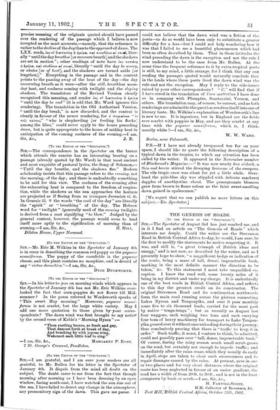THE GENESIS OF ROADS. [To THE EDITOR OF THE "
SPECTATOR.1 • Snt,—The Spectator of August 3rd has just reached me, and in it I find an article on " The Genesis of Roads " which interests me deeply. Could the writer see the Stevenson Road in British Central Africa to-day, he would, I am sure, be the first to modify the statements he makes respecting it. It was, and still is, " a great triumph of British ideas and energy," and is not now, as described by the writer, and as I presently hope to show, " a magnificent hedge or indication of the route, being a mass of tall, dense: impenetrable bush, marking in the most definite manner the direction to be taken," &c. To this statement I must take unqualified ex- ception. I know the road well, some twenty miles of it being in my district and under my charge. It is undoubtedly one of the best roads in British Central Africa, and reflects to this day the greatest credit on its constructor. The original Stevenson Road and its continuation northwards form the main road running across the plateau connecting Lakes Nyassa and Tanganyika, and over it pass monthly some five to six thousand loads, carried for the most part by native " tenga-tenga, " ; but as recently as August last four waggons, each weighing two tons and each carrying four tons of heavy machinery for transport to Lake Tangan- yika, passed over it without once unloading during their journey, thus conclusively proving that there is " traffic to keep it in order." Such traffic, it must, I venture to think, be admitted, could not possibly pass over " tall, dense, impenetrable bush." Of course, during the rainy season much small scrub grows on the road, but certainly not enough to impede traffic ; and immediately after the rains cease, which they usually do early in April, steps are taken to clear such excrescences and to repair damages caused by. the rains. At present, save in one or two places and for very short distances where the original route has been neglected in favour of an easier gradient, the road has a width of from 20 ft. to 30 ft., and is not in the least overgrown by bush or scrub.—I am, Sir, &c.,
H. FARVILL-SCOTT,
H.M. Collector of Revenues, &c.
Fort Har,Brttish Central Africa; October 25M, 1901.






































 Previous page
Previous page